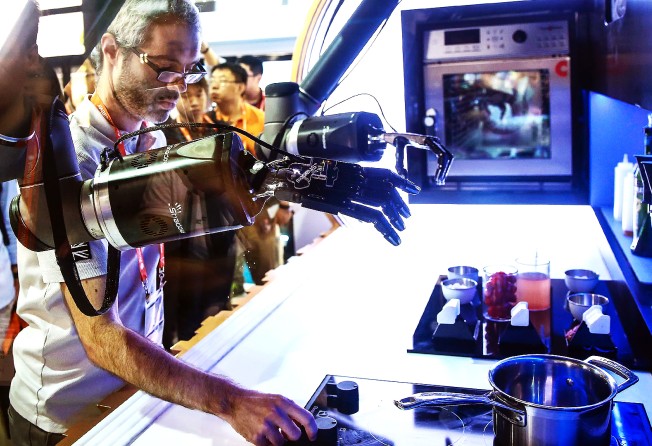'World's first' robot kitchen cooks for visitors at CES Asia in Shanghai

Visitors to the inaugural Consumer Electronics Show (CES) Asia in Shanghai on Monday were cooked food by a robotic kitchen, the first of its kind according to its creators.
Designed by London-based Moley Robotics, the automated kitchen consists of two large robotic arms which can construct dishes based on an iTunes-like library of recipes. The arms were designed by the Shadow Robot company, which also provides technologies to NASA, and consist of 20 motors, 24 joints and 129 sensors allowing them to mimic the movements and dexterity of human hands.
Chef Tim Anderson, a former winner of the BBC's Masterchef competition, acted as a recipe consultant, developing the crab bisque dish that was served to visitors at CES Asia.
“I chose crab bisque as a dish because it’s a real challenge for human chef to make well, never mind a machine," Anderson said.
"If it can cook a bisque, it can do stir-fries and we’re looking forward to teaching it many more recipes in the months to come.”
On display at the conference was full-scale reproduction of Moley's mass-market device, designed to fit in regular kitchens and featuring smaller control arms and dishwashing functionality.
The device - still a prototype for now - is expected to go on sale in 2017, with a library of more than 2,000 dishes.
The robotic kitchen can cook any dish that the chef is able to create as it simply replicates what a human does, said Moley founder and chief executive Mark Oleynik.
“For that reason there is no limit on the amount of recipes,” he said.
More work has to be done on the development of the robotic hand technology and the accompanying kitchen equipment before it can hit the market, he said.
The product on display included a fully equipped kitchen, though there will also be the choice to have the robot integrated into an existing kitchen, he said.
“Some Chinese recipes may require additional equipment, such as a rice steamer, for example. Whatever equipment the chef has used, the robot should also have one. The kitchen robot is able to work with any additional equipment required for the preparation of the dish,” he said.
Oleynik said he began to develop the concept in early 2014, and has been using his own money for research and development of the project, though he declined to say how much.
“I used my own money because I believe in it,” he said. “Many people want to have home-cooked food, but not everybody wants to cook. The robot can do it for you.”
The robot kitchen has attracted strong interest from investors, he said, adding that the company would announce new funding in July.
In the next step, the technology will be developed to let users share their recipes with others, and potentially make money from them, though it will unlikely be carried by the version that will be on sale in 2017, Oleynik said.
Additional reporting by James Griffiths
